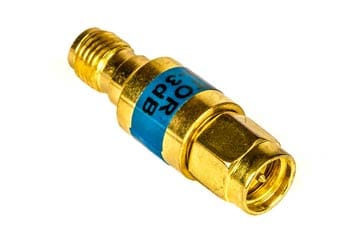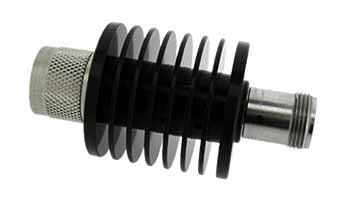RF Attenuator Specifications & Parameters
Understand RF attenuator specifications & parameters so that the correct electronic components are selected for any RF circuit design or system.
Home » Radio & RF technology » this page
RF Attenuators Includes:
Attenuator basics
Attenuator specs
Resistive attenuator design
Attenuator resistor values table
Balanced resistive attenuator pads
Variable PIN diode attenuator
SMA attenuator
There are very many different forms of RF attenuator, fixed variable, low frequency, microwave, those having large attenuation ranges, etc, that it is necessary to understand the various specifications and what to look for when selecting an RF attenuator for an RF circuit design, system, etc.
Ensuring that the attenuator is fit for the RF design or other application is essential, because many of these electronic components are not cheap . . and the cheap models may not be fit for purpose.
Selecting the right RF attenuator is a balance between performance and cost, and then making sure that the component is of a suitable quality. All these factors need to be considered when making the selection.

When designing, purchasing or using an RF attenuator it is necessary to be able to specify it to ensure that an attenuator with the correct performance is obtained. While some of the major specifications are detailed below, for some applications other parameters may need to be specified.
RF attenuator specifications
Attenuation: This is the primary specification for an RF attenuator - all RF attenuators will have this as their primary specification. It is the ratio between the output and the input power levels and is typically quoted in decibels (dB).
As this specification is so key to the attenuator, the attenuation is part of the basic description of the electronic component - it is typically one of the key parameters, and is normally used in the basic description for the attenuator.
Power dissipation: The power dissipation level is probably the second most important parameter for an RF attenuator. In order to reduce the signal level, RF attenuators dissipate or absorb the unwanted power.
For many small signal applications, power dissipation is not an issue, but for other applications where signal levels are higher, it is necessary to ensure that the RF attenuator will satisfactorily be able to handle the power levels anticipated.

Typical high power RF attenuator
Note the heatsink fins to dissipate the powerPower capabilities for RF attenuators may be quoted in Watts (or milliwatts) or as dBW - decibels relative one Watt (or dBm - decibels relative to a milliwatt).
It is important to ensure that the power rating is not exceeded otherwise damage to the attenuator could result. Also if the temperature rise is too high then the impedance of the attenuator may change slightly and cause an issue. In view of the importance of the power rating specification, this parameter is normally mentioned in the top level description for the electronic component.
Attenuator capability: Some attenuators have a fixed value and can be easily inserted into the RF system. Others are switched or variable, and this meeds to be accommodated within the selection.
Variable attenuators tend to be designed within the RF circuit design itself for inclusion in some form of feedback look to maintain a fixed level, etc.
Switched attenuators tend to have binary switching where attenuator sections of 1, 2, 4, 8, . . . dB sections can be switched in as required. With these, ensure that range and minimum switch step meets the requirement. Also ensure that the drive requirements can be accommodated. Switching can be semiconductor or reed relay. The semiconductor ones tend to have a longer life, especially if large numbers of switching operations are required. That said, reed relays are very reliable these days.
Impedance: The impedance of the attenuator is the third important specification. As most RF power transfers are undertaken for 50Ω systems, this is the most widely used level of impedance. 75Ω systems are used occasionally, and for some specialist applications, other impedance levels may be used.
- Attenuation accuracy : It is often necessary to know the accuracy of the level of the attenuation of the attenuator. Particularly in applications where equipment is being tested, the attenuation accuracy is likely to be important. In these cases a tolerance on the nominal level of attenuation will be given.
- Frequency response: The level of attenuation of an attenuator will vary with frequency. This can result from the frequency dependence of the resistors or other components used in the RF attenuator, or where coupling between the input and output may exist as this will be frequency dependent. Some RF attenuators where the absolute level of attenuation is important may be provided with calibration charts measuring the absolute attenuation at different spot frequencies over a frequency band.
VSWR: A specification for the VSWR seen may be included in the data sheet. This indicates the math provided by the RF attenuator. It would be expected to deteriorate with increasing frequency. Ensure it meets the required VSWR level.
- Mechanical details of the attenuator: The mechanical details may include aspects such as the size and weight. The connectors may be included in this area of the attenuator specification.
- Environmental details: Many applications for attenuators are for use within benign conditions such as a laboratory environment. Environmental conditions would not be an issue. However for some applications it is possible that an environmental is required to detail factors such as vibration, temperature, humidity and the like.
Other important aspects for selecting an RF attenuator
Apart from the main specification parameters, there are other considerations when buying an attenuator for an RF circuit design.
Sometimes the non-specification issues can be just as important as the basic RF parameters themselves. When selecting an RF attenuator it is essential to look at all aspects of the electronic component from its specification and parameters, through to other issues that may affect its suitability for inclusion in the RF circuit design.
There are a number of issues that need to be considered:
Cost: Cost is obviously an issue when buying an RF attenuator, especially if it is to be included in an RF circuit design that might have many units manufactured, as the cost will be multiplied many times, and cost savings mount up if they can be made. If it is just for a one-off system then it may not be quite as important, but nevertheless, cost is still an important issue.
Often cost is a factor that needs to be balanced with other factors like the anticipated reliability, availability, how it meets the specification and a number of other factors.
Quality & Reliability: Quality of a product is important for most RF circuit designs as failures can be costly, especially if they need to be repaired when the overall equipment has left the factory. To ensure the optimum quality, obtain the RF attenuator from a reliable supplier and also look at the MTBF figures to gain an insight into its long term reliability.
Supplier: The supplier for the RF attenuator can be important. It will be possible to build up a good working relationship with a good supplier, and within reason obtain product when it is needed. These factors help enormously during the RF circuit design process and can make a significant difference to the ease or development and production, etc.
Availability: With certain products there may be difficulties with obtaining the product when it is needed. If it is not possible to obtain the RF attenuator on time, or if supplies appear to be intermittent, then this could be a very good reason to selecting a different product, possibly from a different manufacturer. However good the product may be, it is no use if it cannot be obtained.
These and other more project specific requirements should be considered as part of the overall decision making process to select the best RF attenuator for the particular applications.
Selecting an RF attenuator for a project, whether it is an RF circuit design for a production run, or for a system such as a test system, or other applications where quantities are smaller, there are many factors that need to be considered from the way in which the particular electronic component meets the specification requirements, to the availability, perceived reliability, and source. All these factors make a major impact on the suitability of a particular attenuator.
 Written by Ian Poole .
Written by Ian Poole .
Experienced electronics engineer and author.
More Essential Radio Topics:
Radio Signals
Modulation types & techniques
Amplitude modulation
Frequency modulation
OFDM
RF mixing
Phase locked loops
Frequency synthesizers
Passive intermodulation
RF attenuators
RF filters
RF circulator
Radio receiver types
Superhet radio
Receiver selectivity
Receiver sensitivity
Receiver strong signal handling
Receiver dynamic range
Return to Radio topics menu . . .



